Here we’re going to explore the phenomenon of the Halloween issue. Countless magazines have put out Halloween-themed “Special Issues” over the decades, which tend to be distinct from the subsequent Christmas Specials in one crucial respect: the latter tailor their content to the season, whereas the Halloween ones more often than not give lip service to All Hallows Eve only on their covers, a definite example of all trick and no treat.
The upside of this tend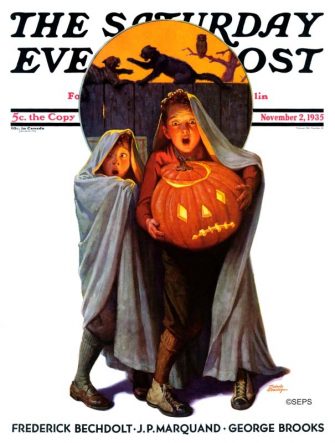 ency is some truly gorgeous cover art. For whatever reason, artists and photographers of all stripes seem particularly inspired by Halloween imagery, which has resulted in museum-worthy images (and ideal collector’s items for those with an interest in evocative magazine covers).
ency is some truly gorgeous cover art. For whatever reason, artists and photographers of all stripes seem particularly inspired by Halloween imagery, which has resulted in museum-worthy images (and ideal collector’s items for those with an interest in evocative magazine covers).
A prime example of this tendency is the November 2, 1935 issue of the Saturday Evening Post, whose cover is graced with a gorgeously rendered Norman Rockwellian painting by Frederic Stanley. Depicting two terrified young boys wrapped in white sheets, one of them holding a massive jack-o-lantern, it’s a deeply striking image that’s now sold as standalone poster art, but if the contents feature anything Halloween related I was unable to find it (unless you count the vintage advertisements, which do seem a mite scary by contemporary standards, in particular the one proclaiming “In past generations, most women approached middle age with bitter resentment at the fate that decided they should be women”).
It followed, FYI, a previous Saturday Evening Post Halloween cover on the November 3, 1934 issue. Painted by Eugene Iverd, it depicts two smiling children lighting a jack-o-lantern amid a placid small town setting, hardly the stuff of which great Halloween illustrations are made. Nonetheless, I quite like a similarly conceived image from Coronet, another old-timey periodical.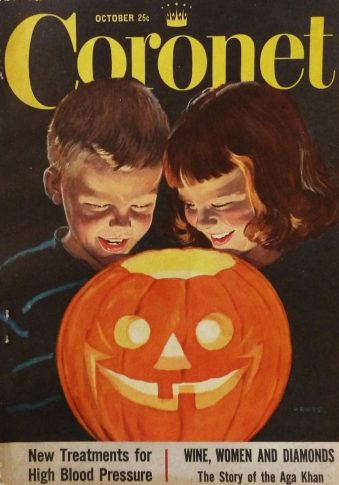
For an example of a magazine that bucked the standard Halloween cover trend see Heavy Metal’s 2006 “Halloween Special,” whose Jim Burns painted cover, depicting a frizzy-haired woman in dominatrix gear, doesn’t seem too Halloween-like. The contents, on the other hand, consist of two longish graphic fantasies that do indeed take into account the October Country. The first is about an afterlife in which the deceased take the form of sentient skeletons in a desolate lunar landscape, and the second a vampire babe in a future world where most everyone has been transformed into zombies or aliens. The artwork in both cases is quite striking, but I’d recommend Heavy Metal’s far more inspired 1997 “Horror Special” in place of this issue.
A 1980s commercial campaign for Family Circle magazine contained an impossible-to-forget jingle proclaiming “There’s nothing square about Family Circle.” I beg to differ, as square is definitely the word for FC’s October 2018 issue, in which are featured “The Busy Mom’s Guide to Beauty” and “Bottoms Up!” (containing the revelation that “There’s more to life than plain black trousers”), and also a longish article about how to create a “crazy-cool” Halloween party that advises its readers to “Spray-paint candlestick holders in varying shades of grey” and that “pumpkins painted all black serve up a bold statement when scattered around.”
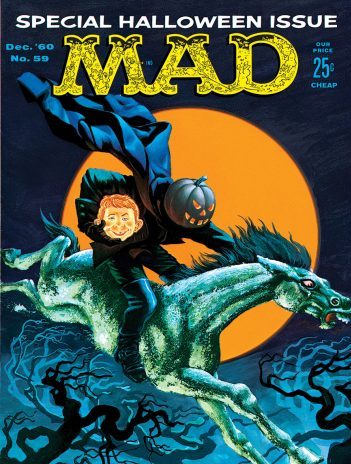 MAD magazine put out a “Special Halloween Issue” in December of 1960, containing one of its most famous covers, courtesy of the great Frank Kelly Freas. Depicted is a jack-o-lantern headed horseman carrying the head of MAD’s gap-toothed mascot Alfred E. Neuman through a landscape of gnarled tree branches. Some (minor) effort was even made to give the interior some Halloween flavor, via a page 3 plug in the “Letters Dept.” for Alfred E. Neuman Halloween costumes (with the accompanying editorial comment “What a sneaky way to get us to plug the costumes so readers know they’re available!”).
MAD magazine put out a “Special Halloween Issue” in December of 1960, containing one of its most famous covers, courtesy of the great Frank Kelly Freas. Depicted is a jack-o-lantern headed horseman carrying the head of MAD’s gap-toothed mascot Alfred E. Neuman through a landscape of gnarled tree branches. Some (minor) effort was even made to give the interior some Halloween flavor, via a page 3 plug in the “Letters Dept.” for Alfred E. Neuman Halloween costumes (with the accompanying editorial comment “What a sneaky way to get us to plug the costumes so readers know they’re available!”).
Cracked, America’s foremost MAD wannabe, put out a Halloween issue “jam-packed with tricks AND Treats” in December of 2000. It at least made a concerted effort to Halloween-ize its contents, which included a spoof entitled “Scooby-Poo…and the Blair Witch Too!,” another called “Haunted Home Shopping Club” (featuring appearances by Frankenstein, the Wolf Man, the Mummy and the masked killer from SCREAM, reminding us that Cracked also put out the spin-off mag Cracked Monster Party from 1988 to 2000) and another called “It’s the Great Punkin Churlie Braun!” (in which the “Punkin” in question turns out to be a malevolent house-sized jack-o-lantern). Unfortunately, none of these pieces are very funny, much less scary.
Another MAD knock-off, the Marvel printed periodical Crazy, contains an iconic Nick Cardy painted cover depicting a heavily 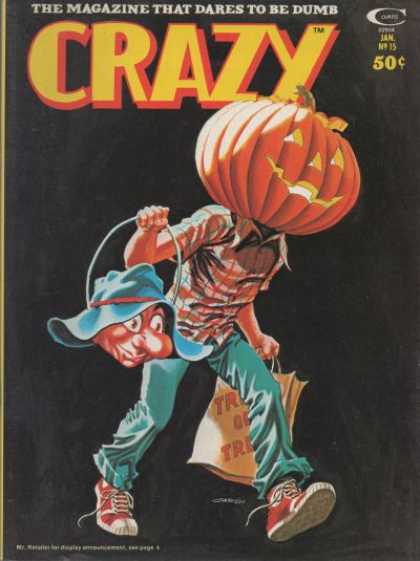 backlit Jack-o-lantern faced trick-or-treater on its January 1976 issue. The interior pages even pay some lip-service to that image, in the form of a JAWS spoof called “Jawbones!” and a feature entitled “Crazy Visits a School for Undertakers.”
backlit Jack-o-lantern faced trick-or-treater on its January 1976 issue. The interior pages even pay some lip-service to that image, in the form of a JAWS spoof called “Jawbones!” and a feature entitled “Crazy Visits a School for Undertakers.”
While on the subject of funny mags, the late National Lampoon would seem to have been tailor-made for satiric Halloween content, but its editors largely ignored All Hallows. The one Lampoon that takes it into account is the October 1980 issue, which features the P.J. O’Rourke penned “Ghosts of Responsibility,” a surprisingly poignant ghost story, as well as a short John Hughes piece entitled “Halloween Rampage,” in which a man recounts some especially outrageous pranks he pulled as a teenager, and the Todd Carroll authored “October 31, 1978,” also concerning troublemaking teens on Halloween.
The cover of the November 1977 “Halloween” issue of Hustler is rather interesting, featuring a nearly-naked woman playing scarecrow—a welcome respite from the usual witches and jack-o-lantern imagery. Of the rest of the issue I’ll say nothing outside the fact that, contrary to what the cover promises, it’s not really Halloween-themed.
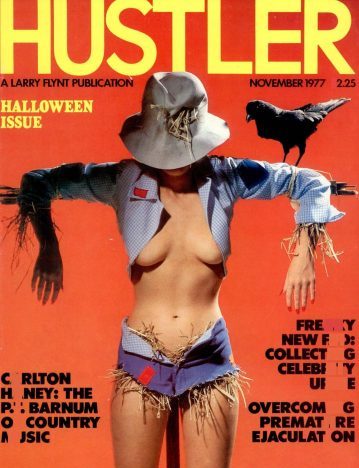 The 2012 Halloween issue of Maxim (“What Guys Want”) at least had the right idea. The naughty nurses cover photo isn’t particularly evocative, but the mag (at least in the “Digital Only Edition” I perused) features around thirty pages of sexy models posing in outrageous costumes that promise “to honor the peerless debauchery that occurs every October 31…the world’s greatest collection of naughty nurses, wonder women, and all the other outfits that make us want to play dress up,” and proclaims “The scariest thing about Halloween isn’t the monsters. It’s meeting a girl with a hard-to-remove costume!” (Meh.) Dudes in monster masks also feature in the photo shoots, which (wisely) give most of the space over to the ladies.
The 2012 Halloween issue of Maxim (“What Guys Want”) at least had the right idea. The naughty nurses cover photo isn’t particularly evocative, but the mag (at least in the “Digital Only Edition” I perused) features around thirty pages of sexy models posing in outrageous costumes that promise “to honor the peerless debauchery that occurs every October 31…the world’s greatest collection of naughty nurses, wonder women, and all the other outfits that make us want to play dress up,” and proclaims “The scariest thing about Halloween isn’t the monsters. It’s meeting a girl with a hard-to-remove costume!” (Meh.) Dudes in monster masks also feature in the photo shoots, which (wisely) give most of the space over to the ladies.
The UK-based fashion mag CT (or Creative Talent) has put out a number of Halloween Specials, portions of which are viewable on issu. The October 2013 issue contains evocative photographic images of models decked out in SILENT HILL faceless zombie get-up, and a young woman made up as HELLRAISER’S Pinhead. It’s by no means great, but these folk at least make a genuine effort to be Halloween friendly.
On the literary side of the street we have two periodicals, the long-running British “Magazine of New Writing” Granta and the Francis Ford Coppola backed Zoetrope All-Story, both of which appeared in fall of 2011, and both of which proclaimed themselves “Horror” issues. A look at the contributors—Will Self, Paul Auster and Don DeLillo are among those of the former, while Jim Shepard and Ryu Murakami grace the latter—amply demonstrate the literary 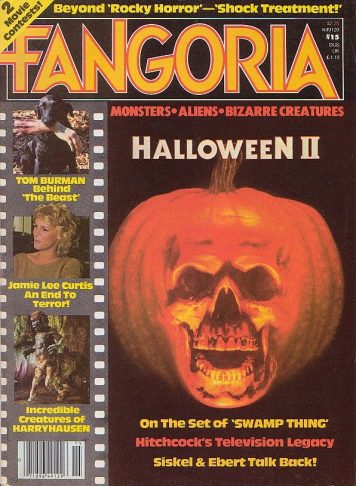 bent fueling these publications. Neither is satisfying in a horror context (the Granta issue, for the record, contains a Stephen King story, “The Dune,” which showcases Big Steve in uncharacteristically subdued and self-conscious form), although both have their good points. Examples of the latter include Shepard’s “HMS Terror,” purporting to be a diary kept during the doomed 1845 Arctic expedition that was also the subject of Dan Simmons’s novel THE TERROR, and Kanitta Meechubot’s “A Garden of Illuminating Existence,” consisting of a series of H.R. Geiger-esque paintings meant to illustrate the author/illustrator’s family tree, but overall I say these are missed opportunities.
bent fueling these publications. Neither is satisfying in a horror context (the Granta issue, for the record, contains a Stephen King story, “The Dune,” which showcases Big Steve in uncharacteristically subdued and self-conscious form), although both have their good points. Examples of the latter include Shepard’s “HMS Terror,” purporting to be a diary kept during the doomed 1845 Arctic expedition that was also the subject of Dan Simmons’s novel THE TERROR, and Kanitta Meechubot’s “A Garden of Illuminating Existence,” consisting of a series of H.R. Geiger-esque paintings meant to illustrate the author/illustrator’s family tree, but overall I say these are missed opportunities.
What might the cure be for the Underachieving Halloween Magazine Blues? Horror mags, of course, although Fangoria, Rue Morgue and Scary Monsters need only advertise a HALLOWEN sequel and/or reboot on their covers to properly reference the holiday. At least you can be certain the content will be sufficiently Halloween-ish, which, as I believe I’ve conclusively shown, is rarely the case with the more mainstream “Halloween” issues.
